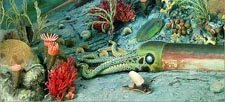 |
 |
 |
 |
 |
Produced
by the Population Genetics and Evolution class, Furman University |
||||
 |
 |
 |
 |
 |
Produced
by the Population Genetics and Evolution class, Furman University |
||||
 |
The
Ordovician: Land Plants |
 |
||
| The colonization
of plants onto land marks a significant transition in evolutionary history.
Plants first evolved from a form of ancestral green algae during the mid-Ordovician
(Steemans et al. 2009). Fossils of spores, called cryptospores, suggest
that the colonization of land plants first occurred through the appearance
of small, nonvascular plants that remained dependent upon the presence
of water as a medium for their swimming sperm (Davis 2003). These cryptospore fossils indicate that these early plant forms were present around 475 million years ago, originating from the Middle East region (Steemans 2008). The early spores differ from modern spores in that they occur in dyads and tetrads, while modern spores are single cells (Davis 2003). The evolution of diapausing spores are crucial in the evolution of plants, since it allowed them, through dormancy, to survive in a wider range of conditions (Steemans 2008). Recent findings indicate that vascular plants appeared as early as around 444 million years ago (Steemans 2008). The discovery of single-celled spores, or trilete spores, suggested that vascular plants were present since the late-Ordovician—significantly earlier than previously believed (Steemans et al. 2009). Seeded plants would not appear for yet another few million years (Davis 2003). Page by Lin Lin Zhao |
 |
| Photo Credit: Science blogs. | |
|
Davis M. 2003. Lush Life: What early land plants can tell us about Earth’s family tree. Perspectives: Southern Illinois University, carbondale. Accessed February 8, 2010. Steemans
P. 2008. Palaeozoic palynology: cryptospores, trilete spores and
megaspores. SciTopics. Accessed February 8, 2010. Steemans
P, Le Hérissé A, Melvin J, Miller MA, Paris F, Verniers
J, Wellman CH. 2009. Origin and radiation of the earliest vascular
land plants. Science. 324: 353. |